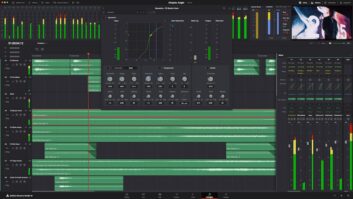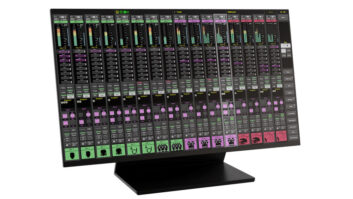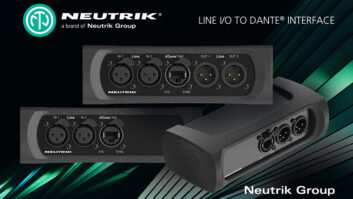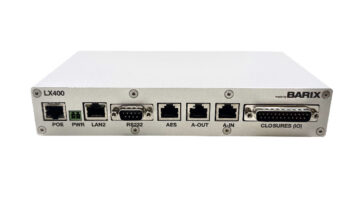Once upon a time, grunge was cool, the Berlin Wall came down, and 20-bit/48kHz recording was considered over the top. It wasn’t long ago that 24-bit/96kHz DAWs were only found in the upper crust of audio facilities, yet 96kHz sampling rates are showing up on more spec lists ever since. Even 192kHz-capable systems are growing in numbers today. Considering that sampling rates ending in megahertz may not be too far away, 96kHz voice-mail attachments may be the norm in e-mails by 2005.
In Mix‘s annual report on the diverse market of studio DAWs, we’ll examine recent developments in 24/96 (and beyond) models, whether they’re in the form of software/hardware “just add computer” packages, one-piece stand-alone wunderstudios, or total turnkey solutions focusing on production systems. DAWs for audio mastering, archiving and restoration are not included.
These days, OS revision and software version numbers like 4.0, 6.0, 9.0 suggest that digital audio has come a long way — or at least gets ever closer to the Holy Grail of “getting it right.” This article focuses on completely new DAW systems and updates to software and hardware platforms that have been introduced over the past year, so we did not include existing high-resolution systems — such as iZ RADAR24, DAR Storm and the Euphonix R-1 — that did not have major upgrades this year.
AKAI
Released last year and now shipping is the new DPS24 ($5,499, with 60GB hard disk and CD-RW drive), a 24-bit/96kHz “digital personal studio” from Akai that offers 56-bit, 4-bus multi-effects processing, a 44-channel digital mixer, optional internal CD-RW drive, and 20 tracks of simultaneous, uncompressed digital recording. Each channel features level, pan, dedicated dynamics processing, 3-band EQ (hi/low shelving and sweepable mids with variable Q), 100mm moving faders and full dynamic automation. Other goodies include phase-coherent time stretching, BPM matching, Normalize and Reverse functions, and an array of inputs and outputs, including 28 analog inputs and a number of I/O options.
Akai has also released Version 2.0 and 3.0 software updates for its popular 24-bit/96kHz digital personal studio, the DPS16 ($2,795). Version 2.0 adds a 4-band stereo multiband compressor, Disk-at-Once CD burning mode and a new Normalize processor. An improved Edit mode allows the user to load and save .WAV files from external SCSI hard disks. Individual tracks can be saved as a mono .WAV file, or pairs of tracks can be selected and saved as stereo .WAV files as well. Two user-programmable scales have been added to the existing 13 preset scales in the unit’s onboard, real-time vocal pitch corrector, and a new smoothing parameter allows for natural vibrato to be retained when correcting voice tracks. A handy new MIDI note-triggering feature allows the DPS16 to track MIDI data from external MIDI keyboards and adjusts pitch in real time. Version 3.0 software, among other improvements, gives DPS16 users the ability to perform sample rate conversion and dithering when reducing 24-bit/96kHz recordings to 16-bit/44.1kHz files for audio CD production.
DIGIDESIGN
Digidesign’s Pro Tools|HD, the company’s next generation of DAW hardware for the Pro Tools platform, is here. Three Pro Tools|HD (High-Definition) systems, each centered around the new HD Core card, offer increased sample rates (up to 192 kHz), higher track counts and I/O capacities, beefed-up DSP power and expanded routing capabilities in a slew of new hardware devices. Pro Tools|HD 1 ($7,995) has one HD Core card with support for up to 32 channels of audio I/O and 96 simultaneous audio tracks with one or more of the new HD interfaces. Pro Tools|HD 2 ($9,995) has an HD Core card and an additional new HD Process card (also sold separately at $3,995/each) to more than double the mixing and processing power of the HD 1 system (up to 64 channels of I/O and 128 simultaneous tracks). The flagship Pro Tools|HD 3 system ($11,995) sports one HD Core card and two more HD Process cards for up to 96 channels of I/O and 128 simultaneous tracks. Each system comes with a free plug-ins promo HD pack and support for all older Pro Tools sessions (full session support for Pro Tools 5.1 and higher projects).
The new Digidesign hardware lineup also includes the 192 I/O ($3,995), 96 I/O ($1,995), SYNC I/O ($2,095), PRE ($2,495), MIDI I/O ($595) and lots of optional equipment. The 192 I/O features a 24-bit/192kHz sampling rate, up to 50 analog and digital ins and outs, and support for up to 16 simultaneous channels of high-definition I/O with Pro Tools software. The 96 I/O offers 8 channels of up to 96kHz in/out performance, and a Legacy peripheral port on both of the new I/O boxes allows connection of existing 888|24, 888|20, 1622 or 24-bit/48kHz ADAT Bridge I/O devices. SYNC I/O provides near-sample-accurate lock to timecode or bi-phase signals and up to 192kHz wordclock I/O compatibility. PRE is a high-performance, remote-controllable, 8-channel analog mic preamp with support for XLR mic, DI and ¼-inch line-level inputs, and full remote control via Pro Tools. (Control|24 and Pro Control remote support is planned.) MIDI I/O is a USB-powered interface with 10 in/out ports, up to 160-channel MIDI operation and support of Pro Tools|HD’s future MIDI Time-Stamping feature.
Digidesign has also been busy updating the Pro Tools software platform. Among other changes, Versions 5.1, 5.2 and the new Pro Tools 5.3 (required for Pro Tools|HD systems) provide a wide range of surround, edit, navigation, MIDI sequencing and session interchange capabilities. Integrated surround mixing, panning and processing features include support for standard multichannel formats such as LCR, Quad, LCRS, 5.1, 6.1 and 7.1. Surround pan controls are now integrated into the main Pro Tools interface, with each track supporting independent panning on its outputs and sends. New mixer architecture allows multiple destinations for each channel output or send, enabling simultaneous mixing to multiple formats. Also, a new I/O Setup window enables users to define custom I/O routings. Multiple levels of undo and the ability to automatically save sessions at chosen intervals are new, and Pro Tools now supports RTAS plug-ins on TDM systems, as well.
Introduced with Version 5.2 (Pro Tools|HD users will have to wait until V. 5.3.2 emerges in Q2 2002) are the RocketNetwork-powered, online DigiStudio and DigiProNet collaboration environments, and Beat Detective, which can perform multitrack rhythm analysis and edit-smoothing functions while it intelligently corrects timing in performances with strong transient points, such as drums, percussion, bass and guitar.
EMAGIC
Scheduled to ship in January 2002, Emagic Logic Platinum 5.0 ($949) is the latest version of the Logic Audio platform, and now features a slew of totally redesigned automation system features, more than 50 onboard plug-ins and new scrubbing functionality. High-end dithering and high-quality audio file support for all Logic Series platforms are included, as are some major Score editor enhancements, new file-format support, and integration of the much-anticipated Logic Control and Logic Control XT. Multiple undo/redo is also due shortly after NAMM, and support for individual output of audio instruments is also planned.
Emagic’s new Logic Control ($1,299) is a hardware controller for Logic Platinum 5 software. A virtually limitless number of Logic Control and Logic Control XT 8-channel expander units ($1,029/each) can link via MIDI, and user-definable button and fader assignments are expected soon. High-quality, 10-bit, 100mm motorized faders from Penny & Giles are included on the Logic Control, and surround mixing parameters such as angle, diversity, LFE and Surround mode are also controllable.
FAIRLIGHT
Fairlight’s new DREAM (Digital Recording, Editing And Mixing) family of digital audio workstations includes the DREAM Station, a completely scaleable turnkey solution featuring the company’s Quad Digital Channel (QDC) technology. (See the December 2001 “Technology Spotlight” in Mix for more information.) Priced at $37,650 for a 24-track/12-bus system with 16 analog outs, eight analog inputs and eight digital I/Os, the DREAM Station incorporates all the functionality of Fairlight’s 48-track DREAM Satellite system integrated into a full spec, fully automated, 56×16 digital mixing system. Every channel on this good-looking DAW is equipped with six bands of EQ and a 2-stage dynamics section, and each bus is equipped with its own bus dynamics and 4-band EQ section. All processing is achieved through 40-bit floating-point DSPs. DREAM Station’s channel dynamics include full sidechain facilities and Fairlight’s DynLink function, which allows any signal or group of signals to derive their control signal from any other individual signal path or group of signal paths.
In order to make third-party software available to its FAME2 and Prodigy2 users, Fairlight has developed the System Services Module (SSM). One of the first SSM applications is the Fairlight Plug-Ins Manager, a hardware and software suite that allows users to run both proprietary Fairlight and commercially available VST plug-ins without interfering with the operational reliability or speed of the Fairlight core operating software. VST plug-ins can now be automated and driven either from the manufacturer’s GUI or from the faders, knobs and switches on the two DAWs’ respective console control surfaces.
MACKIE DESIGNS
Mackie was a veritable business hub in the DAW world the past year. As an OEM, the company builds the new Logic Control and Logic Control XT software control surfaces for Emagic, and, thanks to a strategic partnership with Universal Audio, the U.A.’s UAD-1 Powered Plug-Ins DAW turbo-charger is now being marketed and distributed as a Mackie package. In addition, TC Electronic, Antares and Drawmer are all porting some of their respective processors as plug-ins to Mackie’s D8B digital console. Perhaps most noteworthy, Mackie has acquired Sydec (makers of Soundscape R.Ed software and Mixtreme cards, among other products) and has launched the new Mackie Broadcast Professional family of DAW software and hardware.
The Mackie Broadcast Professional family of products will feel familiar to Soundscape Legacy users, though it may look a little different. The Soundscape R.Ed software and SSHDR-1 hardware have been totally redesigned in the form of the new I/O 896 8-Channel Audio Interface and Soundscape 32 Embedded Hard Disk Recorder.
Soundscape 32 is a new direct-to-disk embedded record engine with a separate dedicated microprocessor board. All programs are stored in ROM, which effectively removes the PC from the data stream and relieves it from all audio processing, playback, storage and synchronization chores. Soundscape 32 offers 32 tracks of 24-bit recording at sampling rates up to 96 kHz, customized real-time digital mixing, a comprehensive automation package, support for third-party plug-ins and EDL compatibility with a variety of video editors. The unit’s back panel offers multiple I/Os, including three TDIF in/out, 2-in/4-out AES/EBU, two 24-bit/96kHz mic inputs and four 24/96 balanced line-level outputs. Additional interfaces include 9-pin remote device control, MIDI I/O and Ethernet support for network access through TCP/IP.
The I/O 896, co-developed with Apogee, brings all of the previous Soundscape audio I/O interfaces’ features into one do-it-all box featuring eight channels of AES/EBU, analog, ADAT optical, multichannel MADI I/O, and the ability to add multiple I/O 896s to any Soundscape 32 studio.
MARK OF THE UNICORN
MOTU’s 896 ($1,295) is a new 96kHz FireWire audio interface for Mac and Windows systems. Providing eight built-in mic preamps and eight 24-bit analog, eight ADAT optical digital and AES/EBU digital I/O channels, the 896 can be stacked for up to 72 total channels of I/O. The 2U front panel provides three banks of 10-segment level meters, eight trim knobs for the analog inputs, and eight toggle switches that select independent 48-volt phantom power for each analog input. No-latency live monitoring is possible with front panel volume control over monitored input signals, and up to four 896s can be daisy-chained for 72 channels of analog and digital inputs and outputs. Connecting to any 1394 FireWire-compliant PC or Mac, the 896 does not require PCI or PCMCIA cards and is bundled with AudioDesk workstation software.
MOTU Digital Performer 3.1, released at AES New York in November, is the first major update since Version 3.0 and represented a major GUI upgrade to this popular software platform, winning an unprecedented third straight Editor’s Choice Award from Electronic Musician. Unlimited multiple undo, branching undo histories and MOTU’s new Timeline Undo have been integrated, the latter allowing users to view an Adobe Photoshop-like, time-based linear representation of a session and revisit a desired state with a single click. Building on 3.0’s extensive surround production features, MOTU has implemented surround support in 3.1’s new built-in Waveform Editor, a feature that lets users perform destructive waveform-editing tasks on surround audio files. Loop-based production enhancements have been added, such as the ability to audition and import REX 2.0 files generated by Propellerheads’ Recycle 2.0 loop-editing software, and, like users of Sonic Foundry Acid, Digital Performer users can now drag-and-drop audio loops that will auto-conform to a song’s tempo.
MERGING TECHNOLOGIES
Debuting at Winter NAMM 2002, Merging Technologies’ Pyramix Virtual Studio 4.1 ($3,000 and up, depending on hardware configuration) runs on a variety of the company’s 96kHz I/O sound cards. Up to eight Mykerinos DSP audio cards can now be configured in a single session, and an increased range of I/O daughter cards now include 16-channel ADAT, 24-channel AES/EBU, 24-channel TDIF, 12-channel SDIF, and 56- and 64-channel MADI options. Support for 192kHz sampling rate is big news, but perhaps even bigger is the fact that Virtual Studio now provides a multitrack DSD/SACD record, edit and mastering solution. (WaveFrame’s FrameWorks/DX with Merging hardware is the only manufacturer to date that is able to claim the same.) Support for Radikal Technology’s SAC-2K controller has been added, as well as support for OMF composition import and direct playback of Akai DD/DR Series disks.
ROLAND
Reviewed in last month’s Mix, Roland’s $4,495 VS-2480 Integrated Audio Production Workstation is exactly that — a “studio-in-a-box.” Features include 24-track 24/96 recorder/editor, 24-channel mixer with stereo and 5.1 mix capability, moving faders and recall of all console functions, onboard DSP, 16-button phrase sampler, CD burner, and mastering operations, with SMPTE and MIDI integration features. The VS-2480 has stereo S/PDIF (coaxial and optical) I/Os, along with Roland’s proprietary R-BUS interfacing for up to 16 simultaneous digital inputs, in addition to the 2480’s 16 analog inputs. Options include a 24-channel meter bridge and a variety of external interfaces — ADAT, TDIF, AES/EBU, S/PDIF, and 8-channel ADCs with mic preamps and phantom power, and analog output DACs. Just announced for the VS-2480 is Version 2.0 software, which supports full operation of the system via a mouse and external VGA screen (including waveform displays) and more.
SADIE
Free to registered users, SADiE’s 4.2 Disk Editor Software update for the 24•96, ARTEMiS and RADiA systems happens to coincide with this British company’s 10-year anniversary. This Windows 2000 Pro- and NT4-compatible 32-bit application offers several display improvements, including individual vertical zoom settings for EDL streams and enhanced waveform viewing for greater precision while editing. The completely reworked Trim Editor interface sports greater functionality, a new Fade Linking feature allows users to further combine and edit fades, and a variety of new preset fade shapes are provided. A stationary timeline in the EDL eases onscreen monitoring of playback, and users with a scrolling mouse wheel can now scroll the playlist virtually. The ability to enable reverse faders in a group, a popular request from SADiE users, lowers selected faders while bringing another up.
SEK’D
The new PRODIF 88 ($799) from SEK’D America is a 24-bit/96kHz, Windows-based, short PCI audio card, one of several that SEK’D offers with its Seqouia 6.0 DAW software. Four balanced stereo AES/EBU digital inputs, four balanced stereo AES/EBU digital outputs, and wordclock input and output are available via a multipin breakout connector bundle. Two balanced ¼-inch analog outputs come right off the PRODIF 88’s backplate. Up to eight channels of simultaneous digital record and playback are possible, and up to four PRODIF 88s can be stacked for 32-channel operation.
SEK’D’s Sequoia 6.0 ($2,999) has truly matured over the years into an impressive platform. Software updates 6.01 through Version 6/beta 6 have netted many enhancements. Punch-in recording is now possible with external sync, the improved Spektroscope display is more accurate, and extended MMC support now displays the current machine position directly in Sequoia’s timebar. Objects can also now be edited and played back during recording, individual tracks can be recorded directly to a number of file formats, and a number of new mastering effects, advanced dynamics effects and 4-band EQ (with high- and lowpass) have been added. WDM-compatible 24- and 32-bit support has been added, as has incremental undo of DirectX plug-in settings and the ability to drag-and-drop EDL files from the command line. Also, AIFF.-reading routines can now accept some non-standard files from other DAWs, such as SADiE systems and others.
STEINBERG
Steinberg Media Technologies is following up its Winter NAMM 2001 release of the Nuendo 8 I/O 96 (price TBA) with a new set of I/O solutions called the Nuendo Audiolink 96 I/O System. Designed for ASIO-compatible production DAWs and based on Hammerfall hardware technology, the Audiolink 96 system incorporates many features found in the Nuendo 8 I/O 96k and Nuendo PCI 96/52 devices. Mac, PC and even Notebook users can achieve 24-bit/96kHz audio performance with claimed latencies as low as 1 millisecond. S/PDIF and ADAT optical and MIDI I/O are included, as are an integrated mixer for ASIO 2.0 direct monitoring and the company’s DIGICheck pro level metering with broadcast-quality peak/RMS values.
The Nuendo Audiolink 96 System consists either of an Audiolink 96 PCI card ($300) or an Audiolink 96 Mobile PCMCIA-type II card ($350) and a choice of I/O solutions. The Audiolink 96 Digiset ($650) offers three ADAT optical, ADAT-Sync In, S/PDIF and wordclock I/Os. The Audiolink 96 Multiset ($850) multichannel I/O provides eight 24-bit/96kHz analog inputs and outputs. Also new from Steinberg this year is Houston ($1,499), a MIDI/USB control surface that handles most every parameter in the VST and Nuendo audio engines and every VST Instrument. Houston features nine touch-sensitive motorized faders, eight rotary encoders with LED position indicators, full transport controls, a jog/scrub wheel, numeric keypad and a large LCD.
Steinberg’s Cubase 5.1 for Mac and Windows, compatible with the company’s Nuendo line of I/O options, has received a lion’s share of new VST Instruments, virtual effect processors, and optimized program code for AMD Athlon, Pentium III and Pentium IV chips (Windows), and Altivec enhancement for Apple Macintosh G3 and G4 computers. The new JX16 (16-voice, dual-oscillator synthesizer), LM-7 (24-bit drum machine with new compressor, 909 and percussion sound sets) and CS-40 6-voice soft synth have been added to an already long list of VST Instruments, and new bit-depth reducing, valve simulating, comb filtering, MIDI gating and seven other new VST Effects processors have been added, as well. Cubase VST/32 ($799.99), the company’s flagship VST platform, now provides ReWire 2 support for Windows users, and the new LTB (Linear Time Base) MIDI Time-Stamping technique, which bypasses the host computer OS for ultra high-speed MIDI timing, has been added to the Mac version.
TASCAM
Tascam’s SX-1 Integrated Audio Production Station ($8,999 with 40GB IDE internal drive) is expected to reach selected dealers in Q1 2002. The SX-1 is a 16-track disk recorder/editor that combines up to 24-bit/96kHz sampling with surround 5.1 mixing, 128 tracks of MIDI sequencing, third-party plug-in effects, a built-in CD-RW drive, enhanced mastering capabilities and more. Tascam’s DM-24 digital console can operate like a sidecar when connected via the SX-1’s cascade port to augment I/O channels, and track count can be increased with an MX-2424 chasing — or being chased by — the SX-1. The lengthy spec list also offers special SX-1 versions of TC Works reverb, Antares mic- and speaker-modeling plug-ins and others, SDII, BWF, .AIFF and .WAV file compatibility, full-feature automation, and a 6-track surround stem recorder that operates side-by-side with the SX-1’s main hard disk recorder.
WAVEFRAME
WaveFrame’s new WaveFrame/7 ($7,995/core; $11,495/rackmount turnkey), released last year and now shipping, offers 24-bit/96kHz audio, 5.1 surround mixing, synchronized integrated digital video playback, up to 32 channels of I/O, and a variety of digital audio interfaces supporting AES/EBU, MADI, ADAT and TDIF I/O. Sound Selector and Volume Manager are two new media-management tools added since this Windows 2000-based DAW was introduced. A wide range of disk file formats and audio file support is offered. Broadcast Wave Files (BWF) are natively recorded and played to standard FAT-32-formatted drives, and the system can also import SD II files recorded on Mac HFS volumes. EDL compatibility has been addressed with options for import and export of Avid OMF, OpenTL (Tascam MX-2424) and previous WaveFrame 6.x projects, and the aforementioned AES31 standard is now fully supported.
WaveFrame’s new Version 4.0 of FrameWorks/DX DAW ($5,495/core; $8,295/turnkey) has added music production-oriented support, like snap-to-grid and bars and beats, and a host of new plug-ins. But the biggest FrameWorks news is eight channels of multichannel SACD environment.
Randy Alberts (www.opendooredit.com) is a California-based audio and music journalist and a frequent Mix contributor. His first book, TASCAM: 25 Years of Recording Evolution, is being published by Hal Leonard Publishing.







